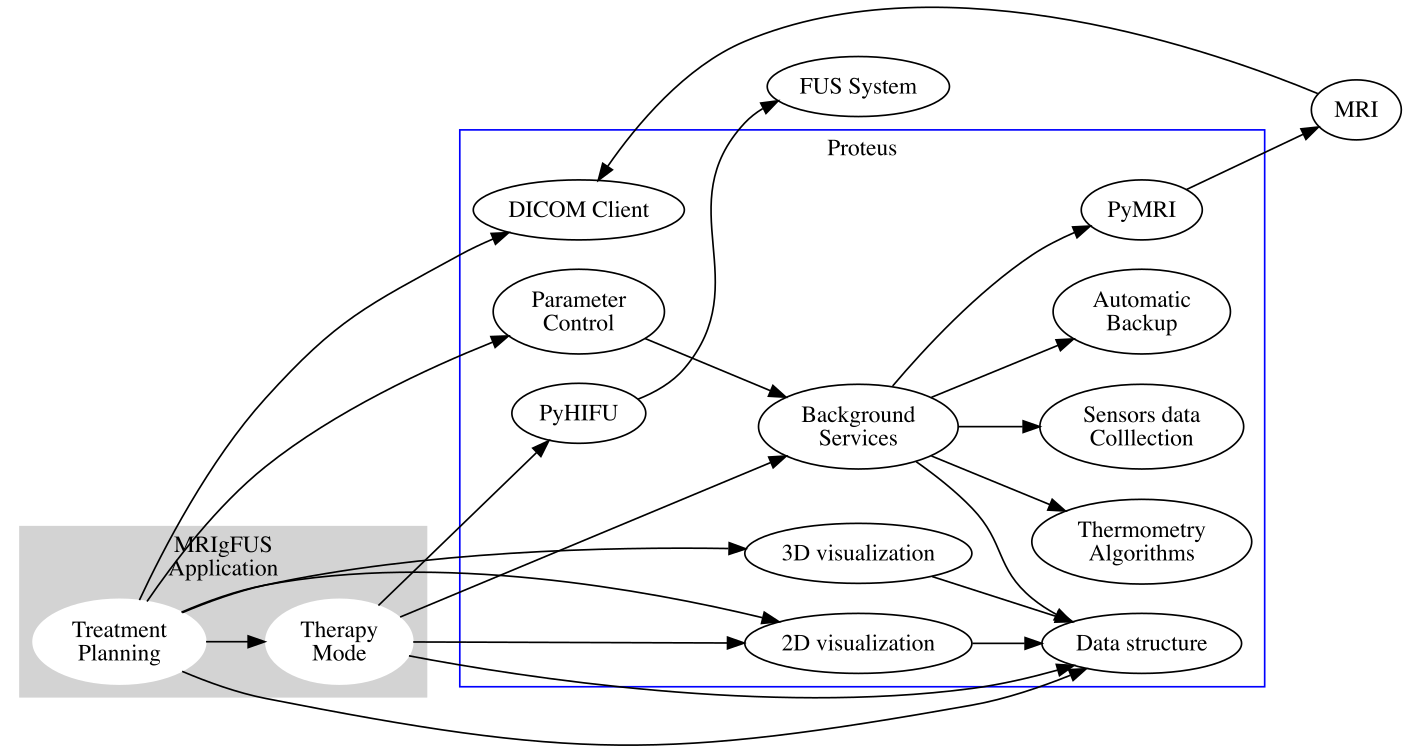Proteus : A Cross-platform, multi-site, MRI-guided and Stereotactic Focused Ultrasound platform
Proteus is an extensive collection of software modules written primarily in Python language for the control of Focused Ultrasound (FUS) therapy under both MRI guidance and stereotactic navigation . Proteus has the significant goal of promoting collaboration among research groups working in this area. Active developers and users of the platform include researchers from the University of Calgary, University of Toronto, UT Southwestern, Princess Margaret Cancer Centre, and The Hospital for Sick Children.
Proteus is the direct project that was born from matMRI and matHIFU. Proteus has been in development since 2013 with the support of a Discovery Grant from the Natural Sciences and Engineering Research Council, shortly after matMRI and matHIFU became public. A lot of the work in many of the last publications from our lab over the last 7 years have utilized Proteus, and helped for its development.
Proteus includes the following major modules:
- Near real- time Magnetic Resonance Image (MRI) data capture compatible with major hardware vendors (Philips, GE, Siemens and Bruker)
- Advanced 2D and 3D user-graphic interfaces
- Support for MRI-guided FUs systems (Sonalleve, FUS Instruments, IGT) and stereotactic FUs systems (FUS Instruments)
- Treatment planning stages with network-enabled medical imaging standard file format transfer (DICOM)
- Near real-time processing for MRI-based thermometry, including several algorithms for motion compensation
- Simultaneous data collection from sensors such as multi-channel temperature probes and oscilloscopes
- Closed-loop control for the delivery of FUs energy using MRI data.
Proteus supports multiple funded projects (NSERC, CIHR) including:
- Development of motion-compensation methods, new robotic system for the exploration of MRgFUS for neonate indications
- Evaluation of embedded antennas for improvement of image quality in MRI-guided FUs
- Exploration of multiple hyperthermia-based applications
- Blood-brain barrier opening
- Neuromodulation with low-intensity FUS
Proteus goes commercial via a collaboration with FUS Instruments
Proteus is now the backend software for the image-guided devices from FUS Instruments. This is a collaboration that initiated formally in Sep 2018 and after very intense months working together we adapted our platform to leverage their hardware systems. This effort brought a large series of innovations including:
For the NeuroFUS Lab at the University of Calgary, this collaboration has also the very strategic goal of having a highly customizable pre-clinical HIFU platform aimed to perform neurostimulation experiments. We quickly added for our needs real-time video capture, control for diverse types of stimuli and more. Even if currently these neurostimulation-oriented features are not yet part of the commercial offer, the testing efforts at the University of Calgary will help to prepare a template for future new opportunities for other groups.
Also, we are currently working with FUS Instruments to leverage our existing components for MRI-guided interventions into their products.
We are thrilled of the future directions this collaboration will bring, especially to expand the use of their platforms.
Proteus is now the backend software for the image-guided devices from FUS Instruments. This is a collaboration that initiated formally in Sep 2018 and after very intense months working together we adapted our platform to leverage their hardware systems. This effort brought a large series of innovations including:
- Support for stereotactic navigation for targeting
- Tight integration with the FUS Instruments hardware to control ultrasound parameters and real-time passive cavitation detection data
- A fully revamped file format based on HDF5 and PyTables that will allows us to manage massive amounts of data, including future efforts to add longitudinal data on the same experiment
For the NeuroFUS Lab at the University of Calgary, this collaboration has also the very strategic goal of having a highly customizable pre-clinical HIFU platform aimed to perform neurostimulation experiments. We quickly added for our needs real-time video capture, control for diverse types of stimuli and more. Even if currently these neurostimulation-oriented features are not yet part of the commercial offer, the testing efforts at the University of Calgary will help to prepare a template for future new opportunities for other groups.
Also, we are currently working with FUS Instruments to leverage our existing components for MRI-guided interventions into their products.
We are thrilled of the future directions this collaboration will bring, especially to expand the use of their platforms.
